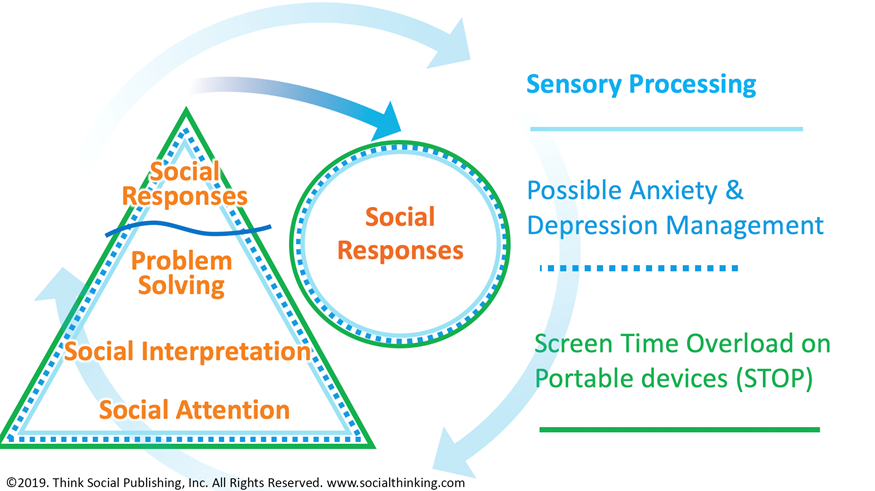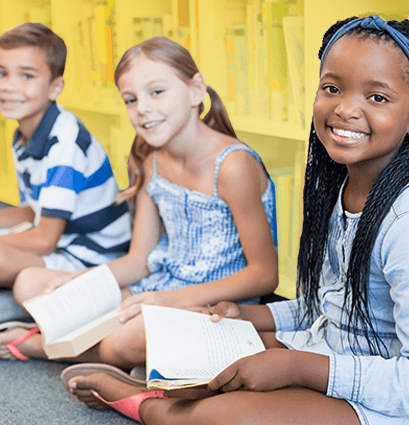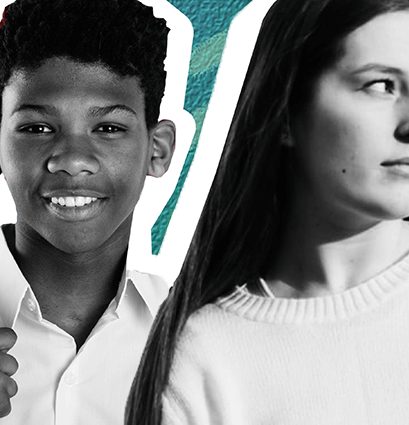Social Learning for a Lifetime of Well-Being
The Social Thinking® Methodology is designed to teach and support individuals, ages 4 and older, how to better understand the social world, foster relationships, develop organizational skills, and build social competencies to meet their authentic social goals. The materials in the methodology are comprised of storybooks, teaching curricula, games, posters, and other products that have been developed alongside our clients and families. Our strategies help to break down complex social and organizational concepts into understandable parts that can be applied across settings. We believe that social concepts like social attention, perspective taking, interpretation, and problem-solving form the foundation of academic standards. These core building blocks promote literacy, collaboration, executive functions, and provide a scaffold for interpreting abstract academic and social information.
Our work is for any individual who has unmet social goals but is experiencing lagging social or organizational strategies to meet those goals, regardless of whether the individual has an educational or medical diagnosis. Our strategies are designed to support the learner “where they are” at that moment in time. Many individuals with social learning differences, difficulties, disabilities, or those with unmet goals have found our materials to be helpful. The methodology focuses on teaching “why” we use social competencies rather than using a behavioral approach to teach people to memorize social skills. For that reason, our materials are a better fit for those who actively think about thinking (metacognition) and have strong expressive language and cognition. And while our work is not a good match for everyone, we promote acceptance and inclusion for all.
The Social Thinking Methodology continually evolves based on the latest research, clinical insights, and input from the educational, therapeutic, and Neurodivergent community. The tools from the methodology have been a source of teaching and supports in specialized groups (Tiers 2 and 3) and mainstream classrooms (Tier 1), as well as workplace office settings. Some age-based curricula have been adopted both schoolwide and districtwide. For more than 25 years, our live conference series, on-demand videos, and free articles have been a guiding resource for schools, homeschools, clinics, offices, and homes around the world.
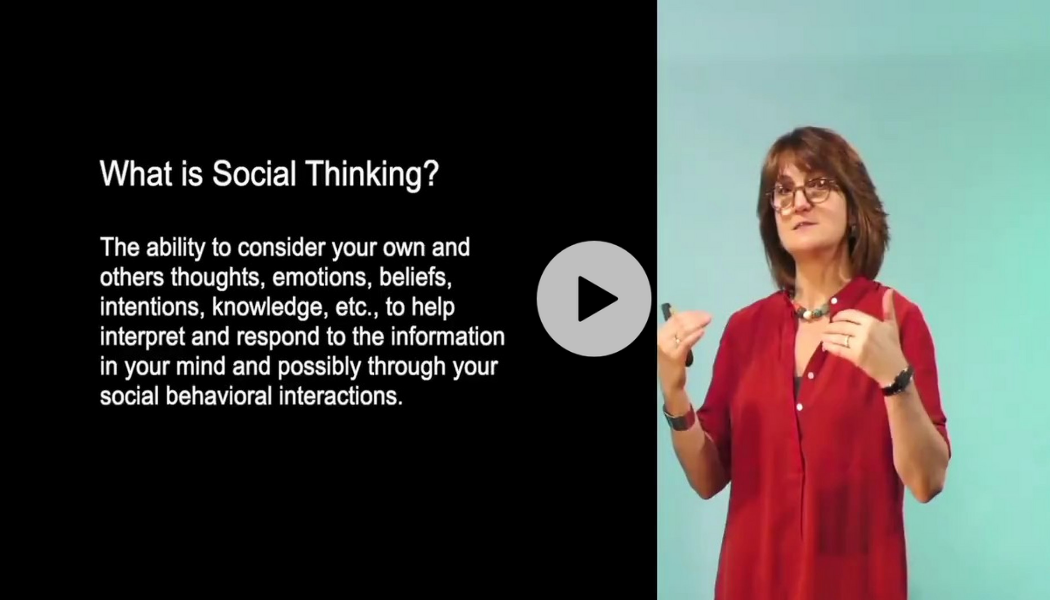
Strategies to Build Social Competencies
The Social Thinking Methodology provides evidence-based strategies to help people ages four through adult develop their social competencies, flexible thinking & social problem solving to meet their own social goals and improve:
- Conversation & social connection
- Executive functioning
- Friendship & relationship development
- Perspective taking
- Self-regulation
- Social Thinking Vocabulary
Who We Help
The Social Thinking Methodology is designed for individuals ages four through adult with solid language, cognitive, and learning abilities. Our work is for individuals with social emotional learning differences and/or challenges, whether neurotypical or neurodivergent (ADHD, social communication learning differences, social anxiety, twice exceptional, autism levels 1 and 2). Our work has been adopted into mainstream classrooms and districts around the world to improve social, emotional, and academic learning for all.
Our strategies are taught by a wide variety of people, including educators, clinicians, families, caregivers, college students, etc. Professionals who use our work include speech-language pathologists, special and general education teachers, social workers, counselors, clinical and school psychologists, occupational therapists, behavior specialists, school administrators, paraprofessionals, marriage and family therapists, and medical professionals, to name a few.
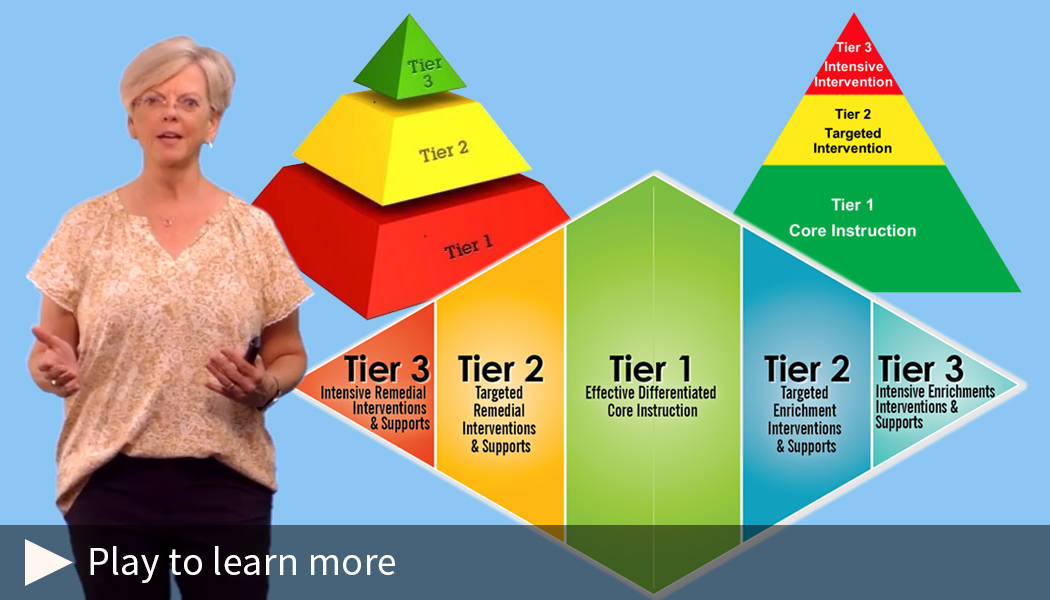
Academics Are Rooted in Social Thinking
How is the Social Thinking Methodology different from every other social and emotional learning program?
- Lessons, strategies, curricula, and tools can cross all 3 tiers of support
- It is designed to complement and embed into academic lessons
- It is accessible to general education and special education
- It uses visual supports and consistent vocabulary to make abstract social ideas clear and concrete
- It avoids assumptions that all learners will learn in the same way
Social thinking is the process by which we interpret the thoughts, beliefs, intentions, emotions, knowledge, and actions of another person along with the context of the situation to understand that person’s experience. If we are engaging or sharing space with another person, we use this information to determine how to respond to affect the thoughts that person has about us to achieve our social goals (such as being friendly to maintain a friendship, acting generous to impress a date, and seeming unfriendly to deflect attention when walking alone late at night, etc.). Social thinking is our meaning maker—it allows us to interpret the deeper meaning behind what others do in the world, and (if the situation calls for it) prompts us with how to respond. A person’s social thinking strength has a considerable effect on their relationships and success in school and at work. It affects the person’s social skills, perspective taking, self-awareness, self-regulation, critical thinking, social problem solving, play skills, reading comprehension, written expression, ability to learn and work in a group, organizational skills, etc.
The same social thinking is required to relate effectively to people around us and is essential for academic success. Students must use social thinking constantly at school—to work effectively as part of a group, stay on task, figure out the expected times to talk in class, and share space well with others in the classroom, cafeteria, and on the playground. Social thinking is also critical for effectively performing individualized academic tasks, such as reading a book. Social thinking is required when reading stories to understand the deeper meaning behind the actions of the characters and their relationships. If a student has poor social thinking abilities, they will struggle to take the perspective of characters, figure out how they are affected by others, and understand why characters act and feel as they do. These students tend to be “more literal” in how they interpret social cues and can have very strong factual learning. They tend to do better with informational text but are weak in comprehending social literature.
Social thinking is also required to write an effective essay. We use social thinking to make sure our arguments make sense to our audience by taking the perspective of the reader and considering what a person may already know or not know about the topic. We must also take the reader’s perspective to consider how to organize the information so it will be logical for the reader to follow. If a student struggles with social thinking, he or she will have difficulty understanding the perspective of the audience and will therefore have trouble writing a persuasive essay that is well-organized and easily understood by others.
Humans practice social thinking all day long, in typical social interactions (like conversations) and in a wide variety of other contexts. Essentially, we use social thinking whenever we think about the perspective of another person. For example,
- At work—when we become aware that by loudly sipping our coffee, we may be bothering our coworkers.
- At the grocery store—when we move our cart away from the middle of the isle so other shoppers can pass by.
- Watching TV—when we follow the story by understanding how the characters interpret and then influence each other.
- While driving—when we slow down upon sensing that another car will cut in front of us.
- When we’re on social media—to understand the intention of a message and its sender; for example, whether it is meant to be friendly, sarcastic, flirty, compassionate, etc.
- In conversation—when we attempt to read the thoughts, beliefs, intentions, emotions, knowledge, and actions of our conversation partner(s) and adapt our behavior to affect the thoughts they have about us.
Strengthening a person’s social thinking begins with improving self-awareness. Only as individuals gain awareness of their own thoughts, emotions, and intentions can they become increasingly aware of the thoughts, emotions, intentions, and actions of others. As a result, they are better able to use the information they’ve gained from their social thinking to inform many things they do throughout the day. Improving a person’s social thinking will help them make progress toward their social goals, such as improving their social skills (social behavior), reading comprehension, written expression, narrative language, ability to work as part of a group, ability to make and keep friends, etc. Much of what we do in school, at work, and as part of the community requires understanding the perspectives of other people. It all requires social thinking.
Remarkably few educators, administrators, counselors, psychiatrists, psychologists, speech-language pathologists, parents, and caregivers are aware of the power of the social mind and how it seeds our ability to think critically and socially problem solve. In fact, many journalists and politicians refer to social skills as “non-cognitive skills,” despite clear evidence that our social behavior is determined by our social cognition (our social thinking) and significantly affects the outcome of our lives!
The goal of the Social Thinking® Methodology is to take complicated social, emotional, and academic learning processes and teach them explicitly in a way that social learners of all ages—and interventionists—can understand. Over the several decades since the Social Thinking Methodology was introduced in the mid-1990s, our work has been and continues to be, informed by many bodies of research and theory. These include, but are not limited to, social learning theory, social information processing, perspective taking, self-regulation, executive functioning, communication, autism, ADHD, sensory processing, reading comprehension, written expression, managing complex behavior, etc.
Ultimately, it became clear that the focus of our work is to teach students social competencies, which are much more than social skills or teaching students to “behave!” Through this process of integrating well-established research studies, including research on social information processing (Crick and Dodge, 1994; Beauchamp and Anderson, 2010) and thought into our methodology, we were inspired to develop the Social Thinking®–Social Competency Model (ST–SCM).
The best way to think about this model is to imagine an iceberg. The swoop on the graphic represents a waterline. What we see above the waterline can be thought of as the social behaviors we notice in one another—just the tip of the iceberg. We refer to these as social behaviors or social responses rather than “social skills.” The foundational, “unseen” social, emotional, and academic learning components below the waterline represent the building blocks of our social competencies. The ST-SCM has four distinct parts, three of which fall below the waterline: social attention, social interpretation, and problem solving. Our social competencies are developmental and continually evolve across our lifetimes.
Most people view social skills (social behaviors/responses) as how an individual behaves, plays, and interacts with others; they teach from the point of view that all social behavior occurs during social interactions. Many do not realize their students need to interpret social information prior to producing relevant and related social responses. Yet, our more sophisticated, highly verbal students need to be taught explicit information to help them understand how the social world works for them to better understand how and why to navigate to regulate in the social world. Think of these as "essential ingredients" for their deeper learning to generalize what they are learning across different landscapes in their social world and handle expanding social expectations as they age.
We invite you to learn more about the Social Thinking–Social Competency Model in our free article and free webinar, or watch the short video lesson below where Michelle Garcia Winner, co-developer of The Social Thinking Methodology, describes the Social Thinking-Social Competency Model.
Michelle Garcia Winner & Dr. Pamela Crooke
Michelle Garcia Winner, MA, CCC-SLP, is the founder and CEO of Social Thinking and a globally recognized thought leader, author, speaker, and social-cognitive therapist. Over her 30-year career, she has developed the Social Thinking Methodology, along with Dr. Pamela Crooke, which provides evidence-based strategies and curricula to help individuals of all ages develop social competencies by deeply connecting social, emotional, and cognitive development. Michelle's work emphasizes the impact of social competencies on relationships, academic performance, and career success.
Pamela Crooke, PhD, CCC-SLP, is Chief Curriculum Officer and Director of Research at Social Thinking. With extensive experience as a speech-language pathologist in the Arizona public schools and as a clinical faculty member of three universities, Pam is a renowned speaker, who has co-authored multiple award-winning books on Social Thinking with Michelle Garcia Winner in addition to co-developing the Social Thinking Methodology.
Michelle Garcia Winner and Dr. Pamela Crooke continuously update the Social Thinking Methodology based on the latest research, input from the community, and insights and evidence from clinical practice.
Three-Part Process
1. Social thinking is our meaning maker. We observe and listen to interpret the perspectives of others. The first step to improving social thinking is to keenly observe the social world that surrounds us.
A client of Michelle Garcia Winner, a 43-year-old engineer, found this step particularly valuable. He spent time learning how to observe people to be more aware of the social situations in which he was expected to socially relate to others. He had this to say about the experience: “Observing the social interactions of others is very helpful to me as I formulate how to interact myself. I’ve learned not everyone walks with their head down avoiding eye contact all the time. I’ve learned when and how to smile. I’ve studied what makes a stranger seem approachable. In short, you have to know the rules of the game in order to play the game.”
2. When seeking to engage or simply share space with others, we use social thinking to adapt our social behaviors (social skills) effectively as a means to meet our social goals. To do this, we must learn strong self-awareness, self-monitoring, and self-control. We must learn how to adapt our physical posture depending on the context, how we use our eyes to better understand others and communicate, and tools for conversational language to relate to others.
3. Our social thinking and social skills directly impact how others feel about us. This impacts how we are treated, how we feel about others, and ultimately, how we feel about ourselves! At the end of the day, our social experience is an emotional experience. The purpose of social thinking is to produce social behavior that gives others the emotional experience you intend to give. The Social Thinking Methodology teaches people to be more aware of their feelings and emotions and better predict and relate to the emotions of others.
The Social Emotional Chain Reaction
The three-part process of social thinking leads to one of the core concepts within the Social Thinking Methodology, the Social Emotional Chain Reaction—the idea that how we act affects how others feel, how we make others feel affects how they treat us, how we are treated affects how we feel about others and ultimately how we feel about ourselves. Throughout our teaching we also highlight the fundamental idea that because we have the power to affect the thoughts, feelings, and lives of others, we have a responsibility to treat others, who pose no harm or threat to us, with kindness and respect. We are affected by others, and others are affected by us! Therefore, we must treat others well to benefit from the same treatment.
The Social Emotional Chain Reaction is at the foundation of social interaction and is at the heart of what we teach through the Social Thinking Methodology. Social Thinking (our company) teaches the Social Emotional Chain Reaction in different ways to different ages through our wide array of products—and to professionals, family members, and students, through our free library of articles and our 40 courses. One of our core treatment frameworks that teaches this concept is Social Situation Mapping, which can be used with all ages.
The Social Thinking Methodology has been a guiding resource for schools, clinics, individuals & families around the world for more than 25 years. Our resources are developed by experts in speech and language (SLPs) specializing in social cognition and dedicated to helping people of all ages reach their social goals. Instead of focusing on mastering social skills, we teach social competencies for lifelong learning, so individuals can make progress toward their self-determined goals.
Teachers, speech-language pathologists, counselors, parents, and therapists just like you have used our evidence-based lessons & strategies to teach people how to improve their social competencies, flexible thinking & social problem solving through: conversation & social connection, executive functioning, friendship & relationship development, perspective taking, self-regulation, and Social Thinking Vocabulary.
Social Thinking resources deeply connect social, emotional & academic learning for a lifetime of well-being. Our materials are helpful for students in mainstream and specialized education—they can be used in schools as part of Tiers 1, 2, and 3 support. Explore our broad range of resources by developmental age below.









